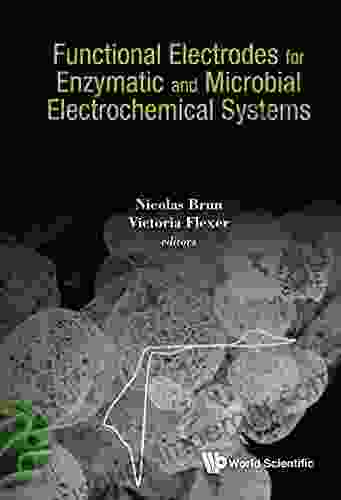Functional Electrodes: The Key to Unlocking the Power of Enzymatic and Microbial Electrochemical Systems

In an era marked by energy challenges and environmental concerns, the development of novel and sustainable technologies is paramount. Functional electrodes have emerged as a pivotal component in enzymatic and microbial electrochemical systems, offering transformative solutions for energy production, environmental remediation, and biosensing. This comprehensive article delves into the fascinating world of functional electrodes, exploring their design, fabrication, characterization, and applications.
4.6 out of 5
| Language | : | English |
| File size | : | 17299 KB |
| Text-to-Speech | : | Enabled |
| Screen Reader | : | Supported |
| Enhanced typesetting | : | Enabled |
| Print length | : | 657 pages |
The Role of Functional Electrodes
Functional electrodes serve as the interface between biological components and electrochemical systems, facilitating electron transfer between enzymes, microbes, and electrode surfaces. These electrodes are tailored to optimize biocompatibility, bioelectrocatalytic activity, and stability, enabling efficient enzyme immobilization and microbial colonization.
Enzymatic electrochemical systems utilize enzymes as biocatalysts, harnessing their specificity and efficiency to perform targeted electrochemical reactions. Functional electrodes provide a stable platform for enzyme immobilization, ensuring their stability and reusability. In microbial electrochemical systems, electrodes act as electron acceptors or donors, enabling microbes to generate or consume electricity while breaking down organic matter.
Design and Fabrication
The design and fabrication of functional electrodes involve careful consideration of several key factors:
- Material Selection: The electrode material should possess high electrical conductivity, biocompatibility, and stability. Common materials include carbon materials (e.g., graphene, carbon nanotubes),metal oxides (e.g., TiO2, SnO2),and conducting polymers (e.g., polypyrrole, polyaniline).
- Surface Modification: Surface modification techniques enhance electrode biocompatibility and bioelectrocatalytic activity. Common modifications include functionalization with biocompatible polymers (e.g., chitosan, polyethyleneimine),immobilization of redox mediators, and integration of nanostructures.
- Microfabrication: Microfabrication techniques enable the creation of complex electrode architectures with tailored surface properties, enabling precise control of enzyme immobilization and microbial colonization.
Characterization Techniques
Characterization techniques are essential for evaluating the performance of functional electrodes:
- Electrochemical Impedance Spectroscopy (EIS): EIS provides insights into the electrical properties of the electrode, including charge transfer resistance and double-layer capacitance.
- Cyclic Voltammetry (CV): CV measures the electrochemical activity of the electrode, providing information about redox reactions and bioelectrocatalytic properties.
- Scanning Electron Microscopy (SEM): SEM reveals the surface morphology of the electrode, providing insights into enzyme immobilization and microbial colonization.
Applications
Functional electrodes have a wide range of applications, including:
- Bioenergy: Enzymatic and microbial electrochemical systems can generate electricity from renewable sources such as biomass and wastewater.
- Environmental Remediation: These systems can degrade pollutants, remove heavy metals, and purify water.
- Biosensors: Functional electrodes enable the development of highly sensitive and selective biosensors for detecting biomarkers, pathogens, and environmental contaminants.
- Bioelectronics: Functional electrodes can be integrated into implantable devices for monitoring and regulating physiological processes.
Functional electrodes are at the forefront of enzymatic and microbial electrochemical systems, unlocking the potential of these technologies for sustainable energy production, environmental protection, and healthcare advancements. Through continuous research and development, functional electrodes will continue to evolve, paving the way for even more groundbreaking applications in the years to come.
4.6 out of 5
| Language | : | English |
| File size | : | 17299 KB |
| Text-to-Speech | : | Enabled |
| Screen Reader | : | Supported |
| Enhanced typesetting | : | Enabled |
| Print length | : | 657 pages |
Do you want to contribute by writing guest posts on this blog?
Please contact us and send us a resume of previous articles that you have written.
 Book
Book Novel
Novel Page
Page Chapter
Chapter Text
Text Story
Story Genre
Genre Reader
Reader Library
Library Paperback
Paperback E-book
E-book Magazine
Magazine Newspaper
Newspaper Paragraph
Paragraph Sentence
Sentence Bookmark
Bookmark Shelf
Shelf Glossary
Glossary Bibliography
Bibliography Foreword
Foreword Preface
Preface Synopsis
Synopsis Annotation
Annotation Footnote
Footnote Manuscript
Manuscript Scroll
Scroll Codex
Codex Tome
Tome Bestseller
Bestseller Classics
Classics Library card
Library card Narrative
Narrative Biography
Biography Autobiography
Autobiography Memoir
Memoir Reference
Reference Encyclopedia
Encyclopedia Charles Mcraven
Charles Mcraven Tammie Southerland
Tammie Southerland Charles R Knight
Charles R Knight Christian Ayne Crouch
Christian Ayne Crouch Jim Webster
Jim Webster Kenneth Hawthorn
Kenneth Hawthorn Chris Walkowicz
Chris Walkowicz Charles M Fox
Charles M Fox L Ofoegbu
L Ofoegbu Wolfgang W Osterhage
Wolfgang W Osterhage Cheryl Harbour
Cheryl Harbour Don Mann
Don Mann John Minnis
John Minnis Christie Mumm
Christie Mumm Darren Freeman
Darren Freeman Ralph R Frerichs
Ralph R Frerichs Christine J Carter
Christine J Carter Christina Riggs
Christina Riggs Cheryl O Brien
Cheryl O Brien Walter Sextro
Walter Sextro
Light bulbAdvertise smarter! Our strategic ad space ensures maximum exposure. Reserve your spot today!

 Jake PowellGlobal Climate Change and Public Health Respiratory Medicine: A Comprehensive...
Jake PowellGlobal Climate Change and Public Health Respiratory Medicine: A Comprehensive... David PetersonFollow ·18.7k
David PetersonFollow ·18.7k Theo CoxFollow ·4.5k
Theo CoxFollow ·4.5k Gage HayesFollow ·4.2k
Gage HayesFollow ·4.2k Darnell MitchellFollow ·13.3k
Darnell MitchellFollow ·13.3k W.B. YeatsFollow ·12k
W.B. YeatsFollow ·12k Pete BlairFollow ·3.1k
Pete BlairFollow ·3.1k Colin FosterFollow ·5.1k
Colin FosterFollow ·5.1k Griffin MitchellFollow ·17.3k
Griffin MitchellFollow ·17.3k

 E.E. Cummings
E.E. CummingsOne Man's Story of What It Meant to be Pj
In the tapestry of life,...

 Caleb Long
Caleb LongPattern Theory in Video Keno: Unveiling the Art of...
Embark on an enlightening journey into the...

 Douglas Adams
Douglas AdamsUnveiling the Diplomatic Landscape: The Ottoman Empire,...
Delving into the History...

 Terry Bell
Terry BellThere Still Is No Off Season: Embracing Year-Round...
In a world consumed by routine and the allure...

 Ibrahim Blair
Ibrahim BlairBrain Teasers Games and Puzzles: Exercise Your Mind with...
Prepare to embark on a captivating journey...
4.6 out of 5
| Language | : | English |
| File size | : | 17299 KB |
| Text-to-Speech | : | Enabled |
| Screen Reader | : | Supported |
| Enhanced typesetting | : | Enabled |
| Print length | : | 657 pages |












